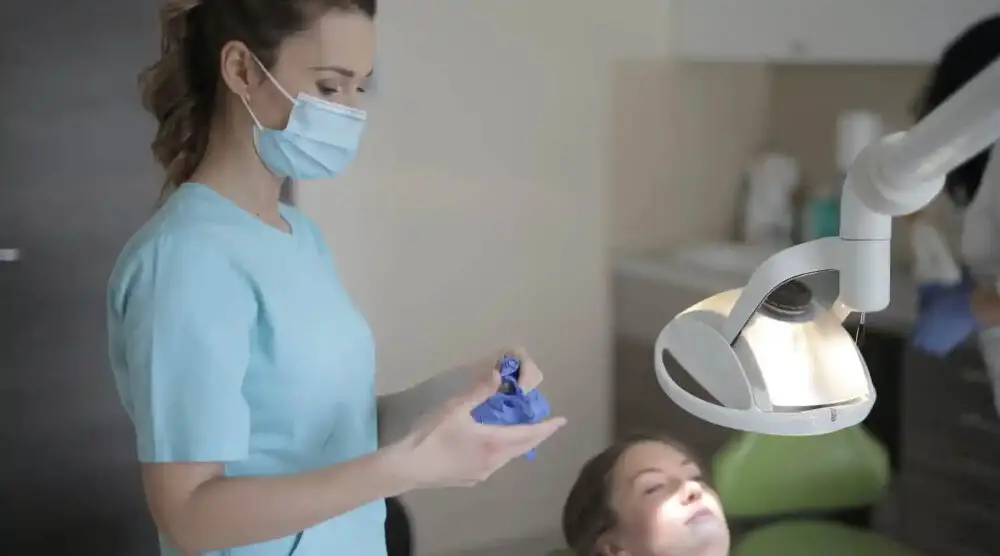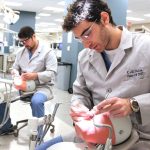When Can You Safely Use Straws After Wisdom Teeth Removal: A Guide to Proper Healing

Wisdom teeth removal is a common oral surgery that many individuals undergo at some point in their lives. As with any surgery, proper healing is crucial to ensure the best possible outcome and prevent any complications. One question that often arises after wisdom teeth extraction is when it is safe to use straws again. While it may seem like a small concern, improper use of straws can lead to a painful and prolonged healing process. In this guide, we will explore the proper healing process after wisdom teeth extraction and when it is safe to reintroduce straws into your routine. After wisdom teeth removal, the healing process can take up to two weeks or longer. During this time, it is important to take special care of your mouth to promote proper healing and prevent infection. This includes avoiding smoking, drinking alcohol, and eating hard or sticky foods. Additionally, it is crucial to avoid using straws or engaging in any sucking motion that can dislodge the blood clot that forms over the extraction site. Failure to properly care for the extraction site can result in a painful condition called dry socket, which can extend the healing process and require additional treatment.
Wisdom teeth removal is a common dental procedure done to remove the third molars at the back of the mouth that often emerge in late adolescence or early adulthood. These teeth can cause overcrowding, pain, infections, and other dental problems. The procedure is usually done under local anesthesia or sedation to minimize discomfort. After the surgery, patients may experience swelling, pain, bleeding, and difficulty opening their mouth. To promote proper healing, patients are advised to follow post-operative instructions, which often include avoiding certain foods, not smoking, and refraining from using straws. Using straws can create suction in the mouth, which can dislodge the blood clot that forms over the extraction site and delay the healing process, leading to dry socket, a painful condition that occurs when the blood clot is lost, and the underlying bone and nerves are exposed.
Proper healing is essential for the recovery and well-being of an individual. Any injury or surgery requires adequate time for the body to repair and restore itself, and this is particularly true for wisdom teeth removal. Following the correct post-operative care instructions, including avoiding the use of straws, can help prevent complications such as dry socket, infection, or bleeding. Proper healing also ensures that the surrounding tissues and bones heal correctly, reducing the likelihood of future dental problems. Therefore, it is crucial to prioritize proper healing after wisdom teeth removal to ensure a smooth and comfortable recovery.
The Healing Process

The healing process after wisdom teeth removal is important to follow to avoid complications and ensure a smooth recovery. It can take several days to a week for the initial healing to occur, during which time it is important to rest and avoid any strenuous activity. Swelling and discomfort are common during this time, but can be managed with pain medication prescribed by your dentist or oral surgeon. Applying ice packs to the affected area can also help reduce swelling and discomfort. One of the most important aspects of the healing process is proper oral hygiene. It is important to keep the extraction site clean to prevent infection and promote healing. Your dentist or oral surgeon will provide you with specific instructions on how to care for your mouth after the procedure, including how often to rinse with salt water and when you can resume brushing and flossing. Following these instructions carefully can help speed up the healing process and reduce the risk of complications.
The healing process after wisdom teeth removal can vary from person to person, but generally, it takes around 7-10 days for the initial recovery. After the surgery, the extraction site will bleed for a few hours, and then a blood clot will form. The first 24-48 hours are crucial, during which the patient should rest and avoid any strenuous activity. Swelling, pain, and discomfort are common during this period, and patients are advised to apply ice packs to the affected area and take prescribed pain medications. By the third day, patients may start to notice an improvement in their symptoms, and the swelling should start to subside. By the end of the first week, the majority of patients should feel comfortable enough to return to their daily routine. However, the healing process is not fully complete, and patients should still be careful while eating and avoid using straws for at least a week to prevent dislodging the blood clot.
During the healing process of an injury or surgery, there are various stages that the body goes through to repair itself. The first stage, called the inflammatory stage, begins immediately after the injury and can last up to three days. During this stage, the body increases blood flow to the area, causing swelling, redness, and warmth. The second stage, the proliferative stage, begins a few days after the injury and can last up to three weeks. During this stage, the body begins to create new tissue to replace the damaged tissue. The final stage, the remodeling stage, can last for several months and involves the new tissue maturing and becoming stronger. It’s important to understand these stages to properly care for an injury or after a surgery, such as wisdom teeth removal, to ensure proper healing and avoid complications.
Why Avoid Straws?

Straws may seem like a convenient tool for drinking, but they can actually be harmful to your oral health, especially after wisdom teeth removal. When you use a straw, you create negative pressure in your mouth, which can dislodge the blood clot that forms over the extraction site. This blood clot is essential for proper healing, as it protects the wound and promotes the growth of new tissue. If the clot is dislodged, it can result in a painful condition known as dry socket, which can delay healing and cause infection. Therefore, avoiding straws is crucial for proper healing after wisdom teeth removal. Furthermore, using straws can also increase the risk of developing cavities and tooth sensitivity. When you drink through a straw, the liquid bypasses your teeth and goes directly into your throat, which means that it doesn’t have the chance to neutralize the bacteria that cause cavities. Moreover, the constant sucking motion can also cause tooth sensitivity, as it can wear down the enamel, exposing the sensitive dentin underneath. Therefore, if you want to maintain good oral health, it’s best to avoid straws altogether and drink directly from a cup or glass.
Dry socket, also known as alveolar osteitis, is a common complication that can occur after wisdom teeth extraction. It happens when the blood clot that forms in the socket where the tooth was extracted becomes dislodged or dissolves before the healing process is complete. This can expose the underlying bone and nerves, causing severe pain and discomfort. Dry socket typically occurs two to four days after the extraction, and it can last for up to a week or longer. To prevent dry socket, it’s essential to follow your dentist’s postoperative instructions carefully, including avoiding smoking, spitting, and using straws for the first few days after the procedure.
Using straws after wisdom teeth removal can potentially lead to a painful condition known as dry socket. This occurs when the blood clot that forms over the extraction site becomes dislodged, exposing the underlying nerves and bone. The suction created by drinking through a straw can easily dislodge the clot, delaying the healing process and causing intense pain. Dry socket can also increase the risk of infection and other complications. It is important to follow your dentist’s instructions and avoid using straws for at least the first week after surgery to ensure proper healing and avoid this uncomfortable condition.
Avoiding the use of straws during the healing process after wisdom teeth removal is crucial to proper healing. This is because of the suction created when using a straw, which can dislodge the blood clot that forms in the extraction site and delay the healing process. Additionally, the suction can cause dry sockets, which are extremely painful and can lead to infections. It is essential to follow the dentist’s instructions and avoid using straws, smoking, or spitting for at least 24 hours after surgery. Proper aftercare is vital to a successful recovery, and avoiding straws is a simple yet important step in the healing process.
When Can You Use Straws?

After undergoing wisdom teeth removal, it is important to properly care for your mouth to ensure proper healing. One of the most commonly asked questions is when it is safe to resume using straws. Generally, it is advised to avoid using straws for at least the first week after surgery. The suction created by the straw can dislodge the blood clot that forms in the socket, leading to a painful condition called dry socket. Dry socket can cause severe pain and delay the healing process. Once the first week has passed, it is important to consult with your dentist or oral surgeon before resuming the use of straws. If there are no complications or signs of dry socket, your dentist or oral surgeon may give you the green light to use straws again. However, it is still important to be cautious and avoid using excessive suction. Sip liquids slowly and gently and avoid chewing on the straw to prevent any complications from occurring. By following these guidelines, you can safely resume using straws without compromising your recovery after wisdom teeth removal.
After wisdom teeth removal surgery, it is crucial to allow adequate time for proper healing before using straws. Using straws too soon after surgery can lead to a condition known as dry socket, which is very painful. Typically, it is safe to use straws after about a week to ten days, but this can vary depending on the individual and the extent of the surgery. It is important to follow the post-operative instructions provided by your oral surgeon or dentist to ensure a successful recovery. In the meantime, stick to a soft-food diet and avoid using straws until you are given the green light by your healthcare provider.
There are several factors that can affect the healing time after wisdom teeth removal. Firstly, the difficulty of the extraction procedure plays a significant role in the healing process. The more complex the extraction, the longer it may take for the wound to heal. Secondly, the patient’s age and overall health status can also impact the healing process. Elderly patients or those with medical conditions may take longer to heal. Thirdly, proper post-operative care, including following the dentist’s instructions and maintaining good oral hygiene, can also affect the healing time. Lastly, the presence of any complications, such as infection or dry socket, can significantly delay the healing process. Therefore, it is crucial to follow the dentist’s instructions and monitor any potential complications to ensure a safe and successful healing process.
When it comes to using straws after wisdom teeth removal, it’s important to take certain precautions to ensure a safe and proper healing process. First and foremost, it’s recommended to wait at least 24 hours before using a straw to avoid dislodging the blood clot that’s formed in the socket. Once you do start using a straw, make sure to only use it for liquids that are not too hot or too cold, as extreme temperatures can cause discomfort and delay healing. Additionally, try to avoid bending or twisting the straw too much, as this can also put pressure on the healing site. By following these tips, you can safely use straws without compromising your recovery.
Other Tips for Proper Healing

Aside from avoiding drinking through a straw after wisdom teeth removal, there are other tips to ensure proper healing. One of the most important things to keep in mind is to follow your dentist’s instructions religiously. Your dentist will give you a list of dos and don’ts that you need to follow to prevent complications and promote healing. These instructions may include taking pain relievers, applying ice packs, and avoiding certain foods. Make sure to follow them closely to avoid any setbacks in your healing process. Another tip for proper healing is to maintain good oral hygiene. Gently brush your teeth and rinse your mouth with salt water to keep your mouth clean and prevent infections. Avoid brushing too vigorously, as this can irritate the surgical site and cause bleeding. Additionally, avoid smoking or using tobacco products, as they can delay healing and increase the risk of complications. With proper care and attention, you can ensure a smooth and speedy recovery after wisdom teeth removal.
A healthy and balanced diet is crucial during the healing process after wisdom teeth removal. It is important to avoid hard, crunchy, spicy, and acidic foods that may irritate the surgical site. Instead, opt for soft and easy-to-chew foods such as mashed potatoes, soup, and smoothies. Incorporating foods high in protein, vitamins, and minerals such as lean meats, fruits, and vegetables can also aid in the healing process. Drinking plenty of water and avoiding sugary and carbonated beverages can also help prevent infection and promote healing. It is important to follow your dentist’s recommendations and avoid using straws until the healing process is complete to avoid dislodging the blood clot that forms in the socket.
Proper oral hygiene is crucial to maintain good dental health and prevent various oral diseases. Neglecting oral hygiene can lead to the buildup of plaque and tartar, which can cause gum disease, tooth decay, and bad breath. It is essential to brush your teeth twice a day using a fluoride toothpaste, floss daily, and use mouthwash to kill bacteria. After wisdom teeth removal, maintaining proper oral hygiene is even more critical to prevent infection and promote healing. It is recommended to avoid using straws for the first few days after surgery to prevent dislodging the blood clot and delaying the healing process. By following proper oral hygiene practices, you can maintain healthy teeth and gums, prevent oral diseases, and promote overall health and well-being.
During the healing process after wisdom teeth removal, there are several activities that should be avoided to ensure proper healing. One of the most important things to avoid is smoking, as the suction can dislodge the blood clot and delay healing. Additionally, drinking through a straw should be avoided, as the pressure can also dislodge the blood clot and lead to dry socket. Consuming hard or crunchy foods should also be avoided, as they can irritate the surgical site and potentially cause infection. It is also recommended to avoid strenuous physical activity for at least a week to avoid any potential complications. Overall, it is important to follow your dentist’s instructions and avoid any activities that may hinder the healing process.
Proper healing after wisdom teeth removal is crucial for the patient’s overall health and well-being. Failure to follow post-operative instructions can result in complications such as dry socket, infection, and delayed healing. It is essential to avoid using straws or anything that can create suction in the mouth, as this can dislodge the blood clot and delay the healing process. Patients should also avoid smoking, drinking alcohol, and eating hard or crunchy foods for a few days after the procedure. Following these guidelines will promote proper healing and prevent complications, allowing patients to return to their normal activities as soon as possible.
The timeline for safe use of straws after wisdom teeth removal is an essential part of the healing process. In the first 24 hours, it’s recommended to avoid using straws as the suction can dislodge blood clots and cause bleeding. From days 2-7, using a straw is permissible but should be done with caution to avoid any negative effects on the healing process. After day 7, using straws is generally safe, but it’s still important to be mindful of any pain or discomfort and to continue to follow post-operative instructions provided by the dentist. Overall, following the proper timeline for the safe use of straws can help to ensure a successful and comfortable recovery after wisdom teeth removal.
Proper healing after wisdom teeth removal is crucial to avoid complications such as dry socket, infection, and prolonged pain. To promote healing, it’s important to follow your dentist’s post-operative instructions, including avoiding using straws for a specific period of time. Additionally, maintain good oral hygiene by gently brushing and rinsing your mouth with warm salt water. Avoid smoking, alcohol, and hard foods that could irritate the surgical site. Get plenty of rest, stay hydrated, and eat nutritious foods to help your body heal. If you experience any persistent pain, swelling, or other concerning symptoms, contact your dentist right away. With proper care and attention, you can safely and comfortably recover from wisdom teeth removal.
Conclusion

In conclusion, the proper healing after wisdom teeth removal is crucial to avoid any complications. The use of straws can delay the healing process and cause dry socket, which is a painful condition that can set back the recovery time. It is best to avoid using straws for at least a week after the procedure and to follow your dentist’s instructions for a safe and speedy recovery. Remember to prioritize your oral health and take the necessary precautions to ensure a successful healing process.







